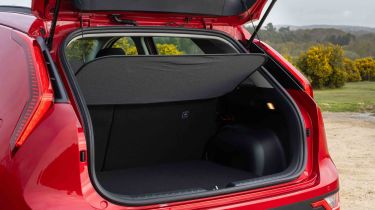Kia Niro - Practicality, comfort and boot space
The Kia Niro has grown, resulting in a generous amount of cabin space and many practical storage options

Given the K3 platform of the Kia Niro has to provide accommodation for hybrid, plug-in hybrid and full EV powertrains, the packaging employed to create space in the cabin is impressive.
There are some clever storage solutions dotted about the Niro’s cabin, too. For instance, the front cubby can be used as either general storage space or, at the touch of a couple of buttons, a pair of cup-holders reveal themselves. There’s more storage under the central armrest, and the glovebox is a decent size, but we found the door bins are very slim, which limits how much stuff you can store in them and means they’re off-limits for larger items.
|
Dimensions | |
|
Length |
4,420mm |
|
Width |
1,825mm |
|
Height |
1,585mm |
|
Number of seats |
5 |
|
Boot space |
451-1,445 litres (HEV), 348-1,342 litres (PHEV), 475-1,392 litres (EV) |
Dimensions and size
The latest Niro is taller, wider and longer than its predecessor at 1,585mm tall, 1,825mm wide, and 4,420mm long. It’s still classed as a compact SUV and is roughly the same size as Toyota’s C-HR and the Skoda Karoq.
Leg room, head room & passenger space
Cabin space was a real plus point of the old Niro, and it’s even better here thanks to the extra length, longer wheelbase and a slimmer front seat design that’s liberated more space for back-seat occupants, among other changes. Even sitting behind a driver over six-feet tall, rear passengers should have plenty of legroom. Headroom is also excellent due to the square crossover proportions of the Niro.
More reviews
Car group tests
- BYD Atto 3 vs Kia Niro EV 3: 2023 twin test review
- MG4 vs Kia Niro EV: 2022 twin test review
- Kia Niro vs Nissan Juke: 2022 twin test review
In-depth reviews
Long-term tests
Road tests
Used car tests
Up front, the low centre console, low window line and decent headroom combine to make the Niro feel spacious and airy inside. Meanwhile, rear passengers will appreciate the USB-C sockets built into the sides of the front seats so they won’t have to fight over who gets to charge their devices.
Boot
Boot space varies for each powertrain. The most spacious is the Kia Niro EV, which has an impressive 475 litres – that’s 53 litres more than the latest Vauxhall Astra – and does not even include the 20-litre storage space under the bonnet. Fold the rear seats down, and the luggage capacity expands to 1,392 litres.
The Hybrid comes next with a respectable 451 litres while, unfortunately, due to the battery being located at the rear, the Niro PHEV’s boot space falls to 348 litres. Folding the Niro’s 60:40 split rear bench gives you 1,445 and 1,342 litres to play with in the hybrid and plug-in hybrid, respectively.
The Niro does have quite a high load lip, which isn’t great when you’re loading heavier items, but the boot opening is nice and wide. We also like the lightweight load cover, which can be twisted and collapsed into a compact disc that you can stow pretty much anywhere.
Towing
The maximum braked trailer weight for the Niro hybrid and PHEV models is 1,300kg, while the EV is only rated to tow up to 750kg.








